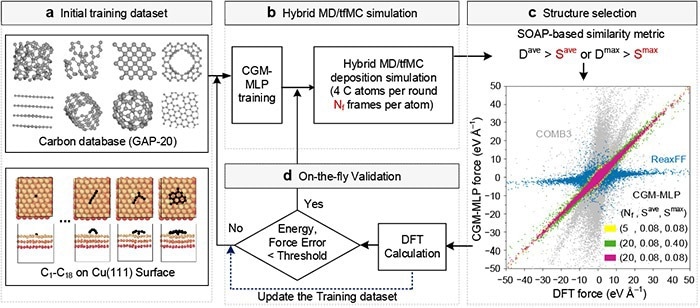Researchers at Tohoku University and Shanghai Jiao Tong University have developed a machine learning method published in Nature Communications, enabling the prediction and control of carbon nanostructure growth on metal surfaces, thus facilitating the exploitation of carbon nanotechnology's chemical versatility in electronics and energy processing devices.
 Schematic illustrations of carbon-growth-on-metal machine-learning potential (CGM-MLP) generated by active learning on-the-fly during hybrid molecular dynamics and time-stamped force-biased Monte Carlo (MD/tfMC) simulations. Image Credit: Hao Li et al.
Schematic illustrations of carbon-growth-on-metal machine-learning potential (CGM-MLP) generated by active learning on-the-fly during hybrid molecular dynamics and time-stamped force-biased Monte Carlo (MD/tfMC) simulations. Image Credit: Hao Li et al.
The formation of carbon nanostructures on various surfaces, including atomically thin films, has been extensively researched, but little is known about the dynamics and atomic-level variables that determine the quality of the resulting materials.
Our work addresses a crucial challenge for realizing the potential of carbon nanostructures in electronics or energy processing devices.
Hao Li, Junior Principal Investigator, Advanced Institute for Materials Research, Tohoku University
The enormous variety of potential surfaces, as well as the process’s susceptibility to several factors, make direct experimental examination problematic. As a result, the researchers resorted to machine learning simulations to gain a better understanding of these systems.
Machine learning can be used to combine data from chemical experiments with different theoretical models to anticipate the dynamics of carbon crystalline development and figure out how to manage it to get desired outcomes.
The simulation program investigates several tactics and determines which are effective and ineffective without requiring human intervention at any stage of the procedure.
The researchers tested this strategy by simulating the formation of graphene, a type of carbon, on a copper surface. After developing the fundamental framework, they demonstrated how their technique could be used for additional metallic surfaces polluted by oxygen, such as titanium, chromium, and copper.
In various graphene crystal formations, the distribution of electrons near atom nuclei varies. These tiny changes in atomic structure and electron arrangement influence the material’s overall chemical and electrochemical characteristics. The machine learning technique can examine how these changes influence the diffusion of individual and bonded atoms, as well as the creation of carbon chains, arches, and ring structures.
The team used experiments to validate the simulation results and discovered that they were very similar.
Li added, “Overall, our work provides a practical and efficient method for designing metallic or alloy substrates to achieve desired carbon nanostructures and explore further opportunities.”
He adds that future research would expand on this to look at areas like the interfaces between solids and liquids in improved catalysts, as well as the chemical characteristics of materials used to process and store energy.
Journal Reference:
Zhang, D., et. al. (2024) Active Machine Learning Model for the Dynamic Simulation and Growth Mechanisms of Carbon on Metal Surface. Nature Communications. doi:10.1038/s41467-023-44525-z.